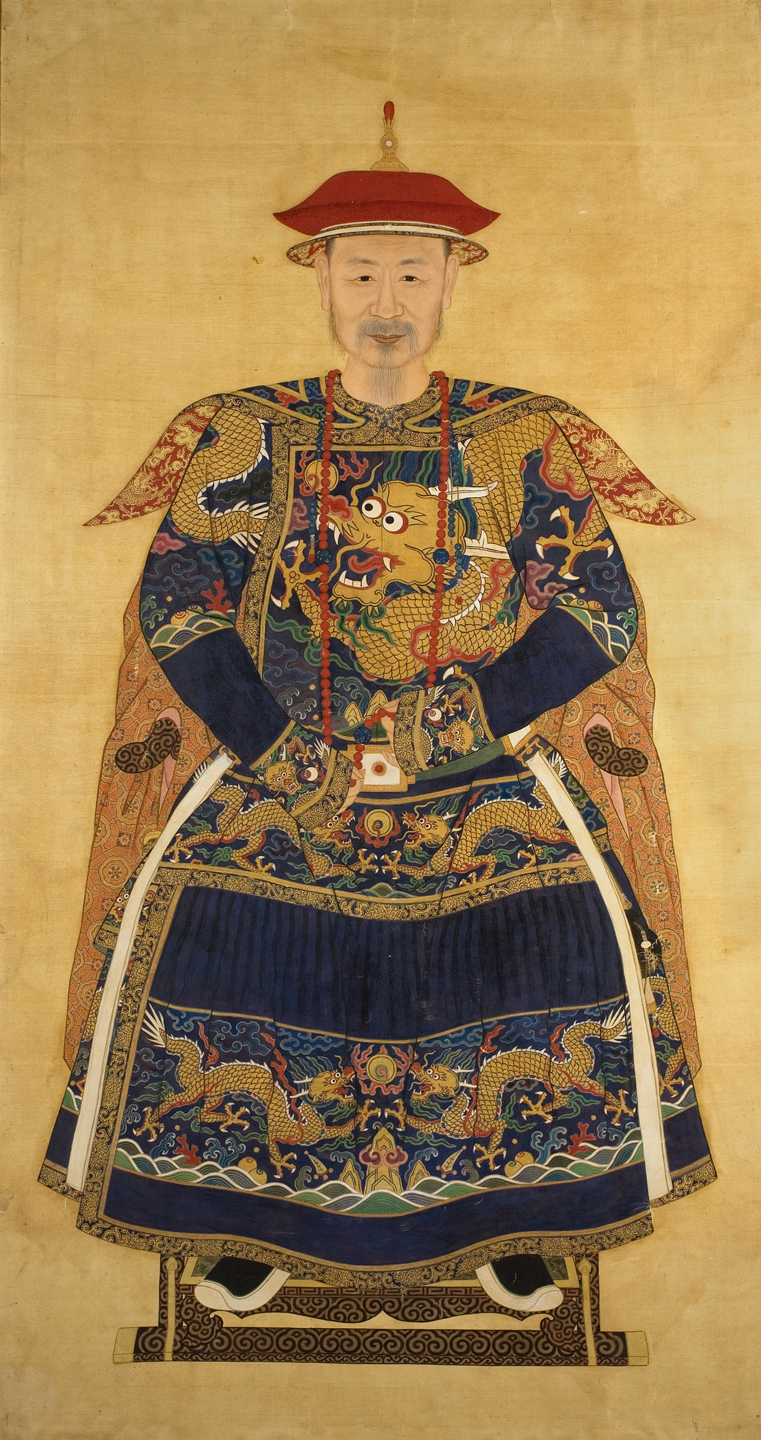Students will examine and discuss the Altar Screen, then collaboratively create a timeline or note on an existing timeline the important historical and political events of northern New Mexico and southern Colorado around the time this screen would have been created and displayed. Students will investigate the significance of cultural works of art relative to the events of the time.
Students will be able to:
- describe and analyze what they see in the Altar Screen;
- discuss symbolic representations and stories found in those symbols;
- use deductive reasoning to decipher information relative to its time in history; and
- interpret information from historical sources about individuals, groups, ideas, and themes in regions of the United States and Colorado, and understand their relationships with one another.
Lesson
- Show students the image of the Altar Screen and ask them to critically examine what they see. Have they seen anything like this before?
- Show students the information from the About the Art sheet and explain that this is a series of retablos, or devotional figures painted on wood, that would have been displayed behind or beside a church altar. Have students look closely at the images. What differences can they see in the paintings? What similarities do they see?
- Explain that objects such as these played very important roles not only in the church, but also in the community and within families. They are a reflection of northern New Mexico and southern Colorado history. A very distinctive regional style developed in this area with influences from Franciscan friars who introduced Catholicism, Native Americans who lived in the area, and Spanish settlers who came to the area from Mexico. Retablos such as these blossomed during the 17th through 19th century. These objects are still being made today in Colorado and New Mexico.
- Locate the regions of northern New Mexico and southern Colorado on a map and note their distances relative to where students live. Discuss what you know about this region and what background knowledge students have of the area. Works of art such as this one can be representative of the political and historical environment of their time period.
- Look at or create a timeline of major cultural and historical events of New Mexico and southern Colorado during this time frame using an example from the History Timelines website or other reliable sources of historical information. Place the creation of the Altar Screen along that time line. What was life like in northern New Mexico and southern Colorado at this time? What can you tell about the cultural and political climate of the states during the time this Altar Screen would have been in use? Consider that Spanish missionaries used works of art such as the Altar Screen as teaching aides to tell religious stories and to convert the native people to Catholicism. How would that affect the dominant culture of the region then and today? You might want to ask students if they think using art or pictures is a good way to communicate with people who speak other languages.
- The materials that were used to make these objects were available in New Mexico and southern Colorado. Native people helped the missionaries or Franciscan friars discover plants that could be used to make pigments and brushes. By 1825, a tradition of using local materials was established and a regional art style developed. There is always give-and-take when two cultures come together. Discuss this idea in small groups or as a whole class.
Materials
- Note-taking paper for each student
- Paper, chart, or white board to display your timeline
- Variety of pencils, markers, or other writing implements
- Timelines of northern New Mexico and southern Colorado history, an example of which can be found on the History Timelines website
- Copies of About the Art sheet on the Altar Screen (found at the end of the lesson plan) or student access to this part of Creativity Resource online
- Color copies of the image for students to share, or the ability to project the image onto a wall or screen
Standards
- Social Studies
- Collaboration
- Critical Thinking & Reasoning
- Information Literacy
- Invention
- Self-Direction
Altarscreen panels mounted in contemporary framework
- Antonio Molleno, American
- Born: New Mexico
- Active Dates: c. 1800 - c. 1850
Molleno worked as an artist in the Chimayó area of northern New Mexico from approximately 1800–1845. He is referred to as a santero—an artist who creates santos, or holy images. A scholar, E. Boyd, discovered a painting of Saint Francis with an inscription on the reverse that reads "San Francisco pitido [sic] el ano 1845 por el escultor Molleno.” “Saint Francis painted in the year 1845 by the sculptor Molleno.” Based on this inscription, art historians are able to attribute other works with matching characteristics to Molleno. During his career, Molleno developed three different styles of painting, referred to as his early, middle, and late periods. He moved from creating somewhat realistic figures to more simplified, abstract figures.
Altar screens were generally placed behind the altar in a church, or on the side walls. The painted wooden panels within the frame, called retablos, depict images of Catholic saints, the Christ Child, and the Virgin Mary. The wooden frame on this screen was designed and created by former Denver Art Museum curator Robert Stroessner, in order to show how the panels would have been displayed in a Catholic church in New Mexico. Santos, the holy images portrayed in the individual panels, served as devotional figures that played an important role in church, community, and family rituals. Saints provided a way for individuals to communicate with God. They are identified by visual attributes, or symbols that represent important aspects of their lives (see examples the "Details” section). Santos also served an educational purpose. The figures portrayed here would have been familiar to most of the church-going population in New Mexico during this time. Many of these people could not read, so images were used to tell stories, instead of the written word.
Details
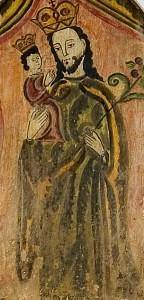
Saint Joseph and the Christ Child
The panel in the center of the top row shows Saint Joseph holding the Christ Child in his right arm, and holding a flowering staff in his left hand.
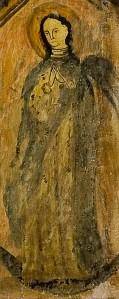
Virgin Mary
The Virgin Mary is located on the right side of the bottom row. She stands on a crescent moon wearing a blue cloak—two visual attributes associated with her.
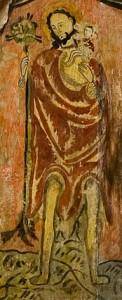
Saint Christopher
Saint Christopher, the patron saint of travelers, can be found in the bottom left panel. A child once asked Christopher to carry him across a river. As they made their way across, the child grew increasingly heavy and Christopher struggled. When they reached the other side, the child revealed himself as Christ, and told Christopher that he had just carried the weight of the world on his shoulders. Christopher planted his staff by the edge of the river where it became a palm tree. He is recognized by the staff he carries in his right hand and the Christ Child in his left.

Saint Barbara
Saint Barbara can be seen in the center panel with a tower in the background. The tower represents a story in which her jealous father locked her in a tower, claiming she was too beautiful to be seen.

Eyes
The eyes of the figures are simplified. A series of semi-circular lines make up the outline of each eye, and a dark dot is used to form the pupil.

Lips
A thin horizontal stripe of paint is crossed by short vertical lines to form the mouth. The lips, along with the eyes, are characteristic of Molleno’s more abstracted style.
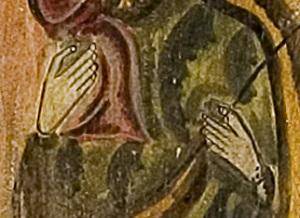
Hands
The hands of the figures are not realistic. The fingers are long, and the thumbs are distended and form awkward angles with the rest of the hand. Notice the disproportionate size of the hands on the image of the Christ Child.
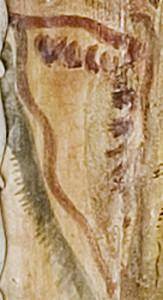
Chili Pepper Elements
The tables and draperies are stylized and look like triangular chili peppers. An earlier name given to Molleno—the “Chili Painter”—refers to his tendency to create these chili pepper designs.
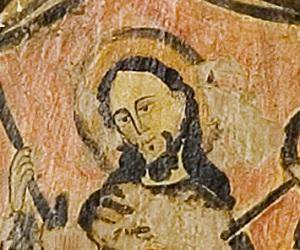
Head
The figures’ heads are turned slightly to the side, so that we are presented with a ¾ view of the face, with a portion of the right side hidden. This position is characteristic of Molleno’s style.
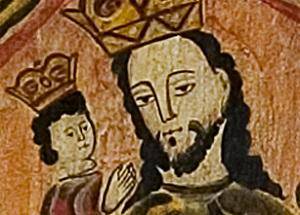
Nose and Beard
Molleno often gave attention to the nose and beard of the figures. Notice here the dark outline around the figures’ noses, and the solid beards on the male figures.
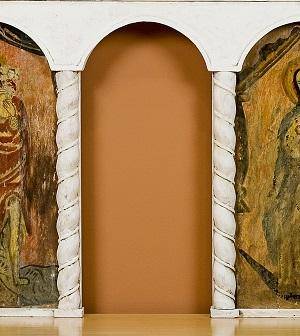
Empty Niche
The empty frame on the bottom row would probably have held a sculpture of a saint, called a bulto. Bultos were also made by santeros.
Funding for object education resources provided by a grant from the Morgridge Family Foundation. Additional funding provided by the William Randolph Hearst Endowment for Education Programs, and Xcel Energy Foundation. We thank our colleagues at the University of Denver Morgridge College of Education.
The images on this page are intended for classroom use only and may not be reproduced for other reasons without the permission of the Denver Art Museum. This object may not currently be on display at the museum.





